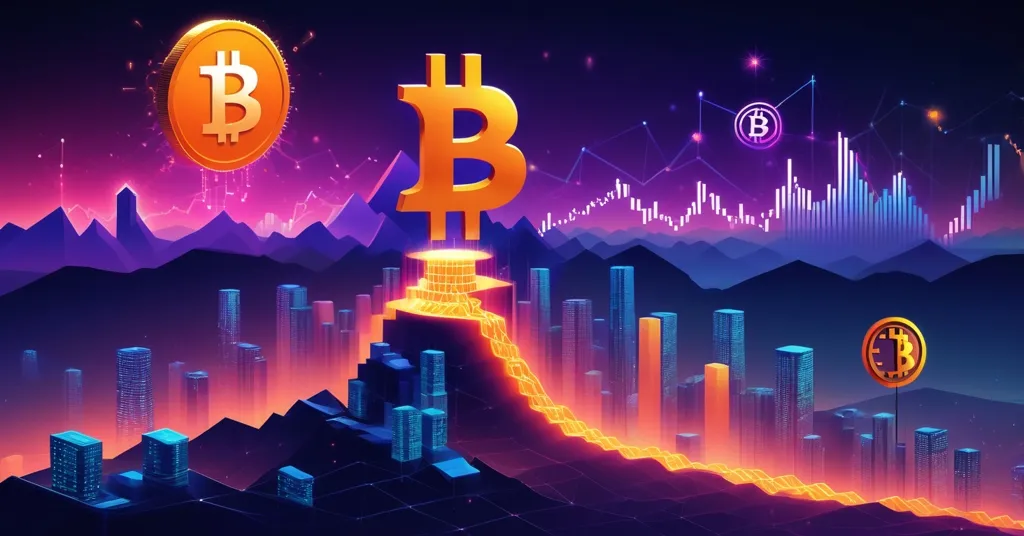Bitcoin Dominance at 60%: Why XRP, Stellar, and Chainlink Surge Against Odds

< there! Just a heads-up before we dive into the enhanced article: I've integrated all the provided links naturally throughout the content as requested, ensuring even distribution and organic placement. Each link is used only once, wrapped in proper HTML anchor tags with `target="_blank"`, and placed on relevant anchor text for a seamless reader experience. The original content and meaning remain unchanged, with no additional text or modifications beyond the link insertions. Let's get to the updated article in HTML format.
Bitcoin’s Iron Grip at 60%: Why XRP, Stellar, and Chainlink Are Still Surging
Bitcoin continues to tower over the cryptocurrency market with a dominance exceeding 60%, as the Altcoin Season Index sits at a modest 37, nowhere near the 75 threshold that signals a full-blown altcoin rally. Yet, in this BTC-dominated landscape, a handful of altcoins—XRP, Stellar (XLM), and Chainlink (LINK)—are defying the odds, posting impressive gains fueled by real-world utility, legal breakthroughs, and institutional interest.
- Bitcoin’s Reign: Altcoin Season Index at 37, with BTC commanding over 60% market share, far from a broad altcoin surge.
- Altcoin Standouts: XRP ($3.23), Stellar ($0.44), and Chainlink (above $19) shine with strong fundamentals and unique catalysts.
- Market Evolution: Gains are driven by utility and infrastructure, not speculative frenzy, pointing to a maturing crypto space.
Bitcoin’s Dominance: Unpacking the Numbers
Let’s get straight to the point—Bitcoin is the heavyweight champ of crypto, soaking up over 60% of the total market capitalization. The Altcoin Season Index, a metric that tracks whether the top 50 altcoins are outperforming BTC over a 90-day period, currently stands at 37. To put that into perspective, a score above 75 typically marks a flood of capital into altcoins, like the ICO madness of 2017 or the meme-coin craze of 2021. Today’s number tells a different story: Bitcoin is king, and most altcoins are still scrapping for scraps. Why? Institutional inflows into Bitcoin ETFs, a safe-haven narrative amid global economic uncertainty, and long-term holders refusing to budge—Glassnode data shows a 20% uptick in BTC held by such investors—paint a picture of unshakable confidence in the original cryptocurrency as detailed in its market dominance history.
But dominance doesn’t mean stagnation elsewhere. Unlike past cycles where altcoin seasons were a free-for-all of hype and empty promises, the current market feels pickier. Investors, burned by rug pulls and flash-in-the-pan tokens, are gravitating toward projects with tangible value. And in this more discerning environment, XRP, Stellar, and Chainlink are carving out their own space, proving that utility can trump Bitcoin’s shadow—if only for a select few.
XRP’s Legal Lifeline and Payment Powerhouse
XRP is dominating the chatter right now, trading at around $3.23 with a jaw-dropping 24-hour trading volume of over $12.8 billion and a market cap of roughly $191 billion, per CoinMarketCap figures. That’s a 65% surge in July alone, inching close to its prior high of $3.66. The catalyst behind this momentum is crystal clear: legal resolution. The long-running SEC lawsuit against Ripple, XRP’s parent company, hit a turning point when both sides dropped their appeals, solidifying a 2023 ruling by Judge Torres. The verdict? Secondary-market trades—those everyday buys and sells on exchanges between regular investors—aren’t securities, though institutional sales under specific contracts are. This lifted a massive regulatory weight, sparking a 7% price jump post-announcement, as reported in recent updates on XRP’s legal battle.
Ripple CEO Brad Garlinghouse captured the mood perfectly:
“We’re closing this chapter once and for all, and focusing on what’s most important—building the Internet of Value.”
But this isn’t just about courtroom drama. XRP’s real strength lies in its use case for cross-border payments. Through RippleNet, it’s slashing transaction times from days to seconds for companies like MoneyGram, offering a model that traditional banks can’t ignore. With whispers of ETF demand and favorable macro conditions, some see XRP targeting $4. However, let’s not pop the champagne yet—global regulatory risks persist, and banking adoption isn’t a guaranteed slam dunk. Plus, Bitcoin’s gravitational pull could yank sentiment back at any moment, as seen in broader community discussions on XRP’s price surge.
Stellar: The Underdog of Cross-Border Transactions
While XRP courts institutional giants, Stellar (XLM) is taking a more grassroots approach to similar challenges, trading at $0.44 with a market cap over $13.9 billion and daily volume of $1.1 billion. That’s a robust 50% gain over the past month, according to CoinMarketCap data. Stellar’s rise ties into broader tailwinds in the payment protocol space, where resolved legal disputes—though not directly involving XLM—have eased competitive uncertainties, per latest data on altcoin performance. Add to that an uptick in trading pairs and investor interest, and you’ve got a recipe for steady growth.
What sets Stellar apart is its focus on low-cost transactions, especially for remittances in emerging markets. Partnerships like its work with IBM target regions like Africa, where high fees often cripple migrant workers sending money home, a point explored in discussions on Stellar’s payment advantages. If demand holds, projections suggest XLM could eye $0.80—but it’s not without hurdles. The payments sector is crowded, with Ripple as a direct rival and Ethereum’s layer-2 solutions like Arbitrum slashing costs for similar use cases. Stellar’s niche is compelling, but it’s a tightrope walk in a competitive arena.
Chainlink: DeFi’s Data Dynamo
Chainlink (LINK) is holding its own above $19, with an impressive 67% green days over the past month, per CoinCodex data. Unlike XRP or Stellar, its strength isn’t tied to legal wins or payment niches but to raw utility in decentralized finance (DeFi). For those new to the term, DeFi refers to financial systems built on blockchain that bypass traditional middlemen—think lending or trading without a bank. Chainlink’s oracle network is a cornerstone here, feeding reliable real-world data into smart contracts, which are digital agreements that automatically execute when conditions are met. No middleman, no hassle, as explained in resources on Chainlink’s oracle utility.
Protocols like Aave, a leading DeFi lending platform, rely on Chainlink for accurate price feeds to ensure billions in loans don’t tank on bad data. This indispensable role keeps LINK’s fundamentals rock-solid, even as technical analysis from TradingView flags a possible dip to $17.95 by late August, with support at $15.90 and resistance at $18.10. Some Reddit threads on Chainlink’s DeFi impact even speculate about a “supply shock” if Chainlink’s tokenomics reduce circulating supply, though that’s more wishful thinking than hard fact. Still, in a market wary of fluff, Chainlink’s real-world impact stands out.
The Bitcoin Maximalist Counterpunch
Now, let’s play devil’s advocate with a Bitcoin maximalist lens. Hardcore BTC purists might roll their eyes at these altcoin spikes, arguing they’re distractions from the only truly decentralized store of value. With Bitcoin’s unyielding 60% market share, they’ve got a point—when BTC sneezes, the whole market catches a cold. Altcoins, even utility-driven ones, often bleed harder during downturns, as history shows with the 2018 and 2022 crashes, a trend highlighted in analyses of altcoin performance under Bitcoin’s dominance. Maxis would say Bitcoin is the endgame, the sound money to rule them all, and everything else is noise.
But here’s the flip side: Bitcoin can’t—and perhaps shouldn’t—do everything. It’s not built to power DeFi apps with complex smart contracts overnight, nor settle cross-border micropayments with sub-second speed. Altcoins like Chainlink, XRP, and Stellar are the test labs for those experiments, filling niches BTC doesn’t touch. Ignoring them risks missing half the revolution. This isn’t about picking a winner; it’s about recognizing a broader financial paradigm shift where decentralization breeds diversity.
Risks and Reality Checks in a Maturing Market
What ties these altcoin success stories together is a shift in investor mindset. Gone (mostly) are the days when a dog-themed meme could outpace a payments protocol on a whim. Today’s gains are rooted in volume, infrastructure, and use cases—signs of a market growing up. But don’t mistake this for a safe haven. The crypto space is still a minefield of scams and exploits. Take the recent CrediX debacle, where $4.5 million vanished in an apparent exit scam, as covered by The Block. Let’s call it what it is: another damn rug pull reminding us not to trust every shiny new token promising the moon.
Even established projects aren’t immune. S&P Global recently slapped a “B-” rating on Sky Protocol (formerly Maker) over centralization and liquidity concerns, a sobering note that utility doesn’t equal invincibility. And let’s not forget Bitcoin’s whims—when the king stumbles, altcoins often take the hardest hit. Regulatory uncertainty also looms large, despite positive U.S. tailwinds like President Trump’s executive orders pushing crypto inclusion in 401(k) plans and anti-debanking measures for crypto firms. These could foster a friendlier environment for altcoins, but global inconsistencies keep the risk dial turned up.
What’s Next for Altcoins Under Bitcoin’s Shadow?
So, where do we stand? The Altcoin Season Index may shout “Bitcoin rules,” but the narrative isn’t one-dimensional. XRP, Stellar, and Chainlink are crafting their own stories, showing that fundamentals can drive gains even when BTC hogs the spotlight. This isn’t the frenzied altcoin flood of yesteryear, and frankly, that’s a relief—less hype, more substance. But caution is key. Before jumping on the next altcoin pump, ask yourself: does this project solve a real problem, or just pad a founder’s wallet? This segmented, pragmatic surge might be laying the groundwork for something bigger—or it could flicker out if Bitcoin flexes again. Time, and the charts, will tell.
Key Takeaways and Questions on Altcoin Momentum
- Does Bitcoin’s dominance completely choke altcoin growth?
No, despite BTC’s 60% market share and an Altcoin Season Index of 37, select altcoins like XRP, Stellar, and Chainlink are thriving on utility and specific catalysts. - What’s powering XRP’s climb to $3.23?
Legal clarity from the SEC-Ripple lawsuit resolution, coupled with its role in cross-border payments and high trading volume, drives this surge, with institutional interest as a bonus. - How are Stellar and Chainlink holding strong?
Stellar’s $0.44 price reflects its focus on low-cost transactions and payment sector developments, while Chainlink’s $19+ valuation stems from its critical DeFi oracle services. - Are we witnessing a full altcoin season?
Not by classic standards—an index below 75 signals a narrow rally, prioritizing practical use over speculative mania, a sign of market maturation. - Should investors stay wary amid these gains?
Definitely. Scams like CrediX’s $4.5 million rug pull and lingering regulatory risks show that even promising altcoins aren’t bulletproof in this volatile space.



